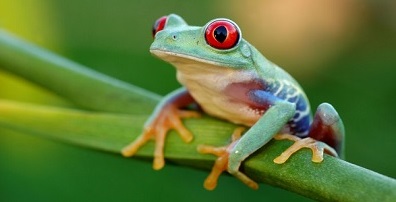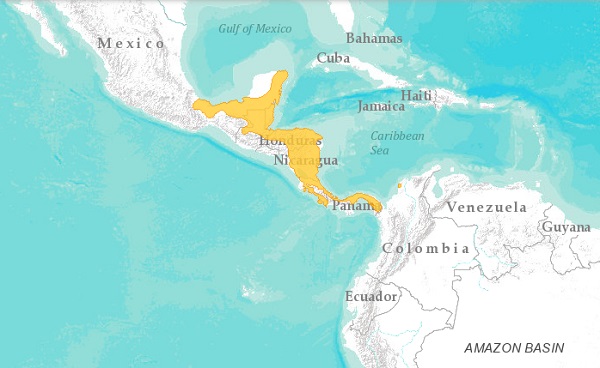Kingdom |
Phylum |
Class |
Order |
Family |
Genus |
Species |
| Animalia | Chordata | Amphibia | Anura | Hylidae | Agalychnis | Agalychnis callidryas |
0

Red eyed tree frog from the National Aquarium
0
Name
- Scientific name: Agalychnis callidryas.
- Common Name: Red eyed tree frog or Red eyed leaf frog.
Range and Habitat
- The red eyed tree frog, also known as red eyed leaf frog, is an amphibian native to Central American countries, specifically to Belize, Colombia, Costa Rica, Guatemala, Honduras, Mexico, Nicaragua and Panama.
- They live in tropical rainforest areas in lowland and mountainous forests with sources of fresh water such as ponds or rivers. High humidity at around 80 to 100%.

Distribution of the red eyed tree frog in Central America. Source: IUCN Red List of Threatened Species.
Physical Features
- Red eyed tree frogs are known for their large red eyes. They work as a form of defense called startle coloration. The color of its eyes scares off predators giving them enough time to escape.
- Its dorsal area is bright neon green which helps it blend with trees. The sides of its body is light blue with yellow stripes.
- Despite their color they are not poisonous like the poison dart frog.
- Its webbed feet and toes are orange or red.
- Males are smaller than females.
- They have suction cup toes that help them attach themselves to leaves, tree trunks and branches.
Size and weigh
- On average the red eyed frog measures 1.5 to 2.75 inches or 4 to 7 centimeters.
- Females are larger than males.
Diet
- They are carnivores eating insects such as crickets, moths, grasshoppers, flies and smaller frogs.
Behavior
- The red eyed tree frog is nocturnal. They are most active during the night and rainy season, they rest during the day hiding in branches where they remain motionless.
- They are arboreal animals meaning that they spend most of their time in trees.
- They ambush their prey with their long sticky tongues.
Reproduction
- Red eyed tree frogs reach reproductive age at 3 to 4 years old.
- They produce during rainy season. The male begins a loud croaking and quivering ritual, jumping from one leave to another to attract females.
- They use a process called amplexus to fertilize the eggs. Once the eggs are fertilized the female deposits her clutch on leaves near a source of water.
- The tadpoles develop inside the egg. One week later the membrane ruptures and the tadpoles fall into the water below.
- Tadpoles metamorphose into frogs and feed from flies and other small insects during their first months of life.
Life Expectancy
- An average of 5 years in captivity.
Threats
- Loss of habitat due to logging, farming and human encroachment.
Conservation Status
- The IUCN Red List of Threatened Species lists the red eyed tree frog as a “Least Concern” species.
